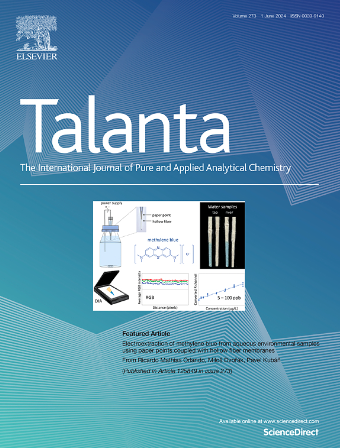用于汗液中氯离子和尿酸检测的纸基微流控电化学传感器
IF 6.1
1区 化学
Q1 CHEMISTRY, ANALYTICAL
引用次数: 0
摘要
氯离子和尿酸是两个关键的生物标志物,在氧化应激中起着至关重要的作用,氧化应激是一种病理状态,如果不及时监测和识别,可能导致严重的疾病。在这项工作中,我们专注于开发一种基于电化学传感器和纸微流体系统的创新装置,用于早期检测汗液中的这些生物标志物。该电化学传感器由一个硅芯片组成,其中包含由银电沉积修饰的薄膜金电极,以及还原氧化石墨烯和金纳米颗粒的复合材料,分别用于检测氯离子和尿酸。采用计时电流法对传感器在缓冲液和人工汗液中的批量性能进行了初步评估。在两种介质中均获得了校准曲线。氯化物离子在缓冲液中检测范围为1 ~ 100 mM,灵敏度为1.40 μA mM−1;在人工汗液中检测范围为1 ~ 100 mM,灵敏度为1.44 μA mM−1。尿酸在缓冲液中的检测灵敏度为1.610 μA mM−1,线性范围为10 ~ 500 μM。人工汗液中对应值为1.583 μA mM−1和10 ~ 500 μM)。这些分析值表明,当在人工汗液中进行测量时,干扰最小,矩阵效应非常小。传感器与纸质微流控组件集成,以评估该装置在极低样本量(7 μL)下监测汗液中氯离子和尿酸水平的有效性,以无创和低成本评估氧化应激。本文章由计算机程序翻译,如有差异,请以英文原文为准。

Paper-based microfluidic electrochemical sensor for chloride ion and uric acid detection in sweat
Chloride ions and uric acid are two key biomarkers that play a crucial role in oxidative stress, a pathological condition that can lead to serious diseases if not monitored and identified on time. In this work, we focus on developing an innovative device based on an electrochemical sensor and a paper microfluidic system for the early detection of these biomarkers in sweat. The electrochemical sensor consists of a silicon chip containing thin-film gold electrodes modified by electrodeposition with silver and a composite of reduced graphene oxide and gold nanoparticles for the detection of chloride ions and uric acid, respectively. An initial performance assessment of the sensors in batch in buffer and artificial sweat solutions was conducted using chronoamperometry. Calibration curves were obtained in both media. Chloride ions were detectable in the range of 1–100 mM with a sensitivity of 1.40 μA mM−1 in buffer, while the range and sensitivity in artificial sweat were 1–100 mM and 1.44 μA mM−1. Uric acid was detectable with a sensitivity of 1.610 μA mM−1 and a linear range of 10–500 μM in buffer. The corresponding values in artificial sweat were 1.583 μA mM−1 and 10–500 μM). These analytical values indicate minimal interference and a very small matrix effect when measurements were conducted in artificial sweat. The sensors were integrated with a paper microfluidic component to assess the effectiveness of the device in monitoring chloride ion and uric acid levels in sweat with a very low sample volume (7 μL) for non-invasive and low-cost evaluation of oxidative stress.
求助全文
通过发布文献求助,成功后即可免费获取论文全文。
去求助
来源期刊

Talanta
化学-分析化学
CiteScore
12.30
自引率
4.90%
发文量
861
审稿时长
29 days
期刊介绍:
Talanta provides a forum for the publication of original research papers, short communications, and critical reviews in all branches of pure and applied analytical chemistry. Papers are evaluated based on established guidelines, including the fundamental nature of the study, scientific novelty, substantial improvement or advantage over existing technology or methods, and demonstrated analytical applicability. Original research papers on fundamental studies, and on novel sensor and instrumentation developments, are encouraged. Novel or improved applications in areas such as clinical and biological chemistry, environmental analysis, geochemistry, materials science and engineering, and analytical platforms for omics development are welcome.
Analytical performance of methods should be determined, including interference and matrix effects, and methods should be validated by comparison with a standard method, or analysis of a certified reference material. Simple spiking recoveries may not be sufficient. The developed method should especially comprise information on selectivity, sensitivity, detection limits, accuracy, and reliability. However, applying official validation or robustness studies to a routine method or technique does not necessarily constitute novelty. Proper statistical treatment of the data should be provided. Relevant literature should be cited, including related publications by the authors, and authors should discuss how their proposed methodology compares with previously reported methods.
 求助内容:
求助内容: 应助结果提醒方式:
应助结果提醒方式:


